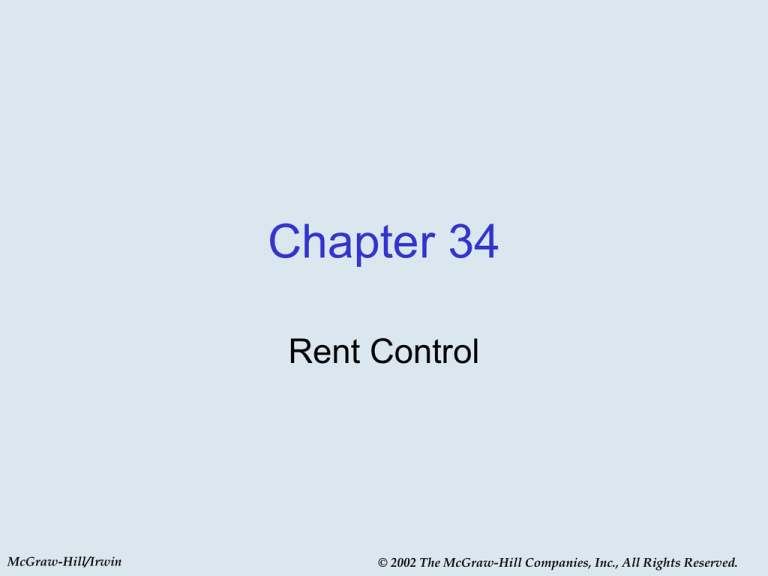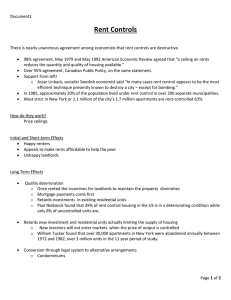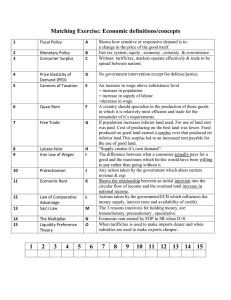
Chapter 34
Rent Control
McGraw-Hill/Irwin
© 2002 The McGraw-Hill Companies, Inc., All Rights Reserved.
Chapter Outline
• RENTS IN A FREE MARKET
• REASONS FOR CONTROLLING
RENTS
• CONSEQUENCES OF CONTROLLING
RENTS
• WHY DOES RENT CONTROL
SURVIVE
McGraw-Hill/Irwin
© 2002 The McGraw-Hill Companies, Inc., All Rights Reserved.
Rent Control
• Laws that restrict the ability of landlords to
raise the rent from one year to the next.
• This is a form of a price ceiling (the level
above which a price may not rise).
• These laws are more prevalent on the coasts:
Boston, New York City, more than 100 cities
in New Jersey, and San Francisco and San
Jose in California.
• Such laws typically come into being when
market rents are rising quickly.
• The east coast laws date from World War II
and the west coast laws date from the
skyrocketing land prices during the 1970s.
McGraw-Hill/Irwin
© 2002 The McGraw-Hill Companies, Inc., All Rights Reserved.
Rents in a Free Market
Rent
Supply
A
R*
C
B
Demand
0
Q*
McGraw-Hill/Irwin
Quantity
• Value to the renters:
• 0ACQ*
• Renters pay landlords
• OR*CQ*
• The variable cost to landlords:
• OBCQ*
• Consumer Surplus to renters:
• R*AC
• Producer Surplus to landlords:
• BR*C
© 2002 The McGraw-Hill Companies, Inc., All Rights Reserved.
Rent Control Relevance
• Rent control is only relevant if it is below the
market rent.
• A controlled rent above the market rent is
irrelevant.
– The landlord must accept the market rent to attract
tenants.
– Charging above the market rent is not in the
landlord’s interests because such a rent would not
attract tenants to the landlord’s building.
McGraw-Hill/Irwin
© 2002 The McGraw-Hill Companies, Inc., All Rights Reserved.
What’s Wrong with the Rent
Control
• The gain to the renters who keep their
apartments and pay less rent is less
than the loss to the losers who are
– people who lose their apartments and
– landlords who receive less rent.
McGraw-Hill/Irwin
© 2002 The McGraw-Hill Companies, Inc., All Rights Reserved.
Demonstrating the Case
Against the Rent Control
•
Rent
•
Supply
A
•
E
R*
C
Rmin
F
•
B
0 QS
McGraw-Hill/Irwin
•
Q* QD
Demand
•
Quantity
Value to the renters:
• 0AEQs
Renters pay landlords
• ORminFQs
The variable cost to landlords:
• OBFQS
Consumer Surplus to renters:
• RminAEF
Producer Surplus to landlords:
• BRminF
People who must move out:
• Q*-QS
© 2002 The McGraw-Hill Companies, Inc., All Rights Reserved.
The Short and Long Run
Consequences of Rent Control
• In the short run supply and demand for
apartments in inelastic. Rent control
lowers rent without much displacement
of renters.
• In the long run supply and demand for
apartments gets more elastic and the
negative consequences become more
pronounced.
McGraw-Hill/Irwin
© 2002 The McGraw-Hill Companies, Inc., All Rights Reserved.
Comparing the Short Run and
the Long Run
Rent
Rent
Supply
R*
Supply
R*
C
Rmin
C
Rmin
0
QS Q*QD
Demand
Quantity
The Short Run
McGraw-Hill/Irwin
0 QS
Q* QD
Demand
Quantity
The Long Run
© 2002 The McGraw-Hill Companies, Inc., All Rights Reserved.
Consequences of Rent Control
• Landlords have a motivation to get tenants
out of their building by failing to maintain it.
• Renters have an interest in “selling” (on an
illegal black market) their rights to a lease.
• People go to funerals to negotiate subleases
from the dead person’s executor.
McGraw-Hill/Irwin
© 2002 The McGraw-Hill Companies, Inc., All Rights Reserved.
Why Rent Control Survives
• The people who benefit from Rent Control
(people who continue to live in the same
apartment for years) are the same people
who vote.
• By definition, someone who is displaced from
an apartment or someone who would like to
move in but cannot find a place, cannot vote
to overturn the law because they do not live
in the city.
McGraw-Hill/Irwin
© 2002 The McGraw-Hill Companies, Inc., All Rights Reserved.







